- Home
- Keith Douglass
Alpha Strike c-8 Page 5
Alpha Strike c-8 Read online
Page 5
Unfortunately, the enlisted personnel didn’t seem to care. At least half of the men hadn’t bothered to shave. While some of them might not even need to shave on a regular basis, three petty officers sported rough-looking stubble. The five women in the Branch particularly dismayed him. He’d expected the women to take a little more pride in their appearance. Two of them had long hair straggling out from underneath their cranials, and one wore the grimiest looking coveralls he’d ever seen.
Bird Dog returned the Chief’s salute, trying to conceal his dismay. They must be testing him, he thought. Trying to see how far they could go with him. Well, he wouldn’t stand for it!
“Personnel inspection, Chief,” he snapped.
The Chief looked startled. “Sir, we’re setting flight quarters in thirty minutes. The FOD walk-down-“
“How long can it take with fifteen people?” Without bothering to see if the chief followed him, Bird Dog began pacing down the row of assembled sailors.
“Haircut,” he said shortly, as he looked the first sailor over carefully. “That goes for just about all of them, Chief.”
“Yes, sir,” the Chief said. He walked slowly down the first line, then the second. Halfway through the third rank, he came to the young female sailor in grimy coveralls. The top of her head barely came up to his wings, and her short blond hair was in disarray.
“Why isn’t this sailor wearing a cranial, Chief?”
“Uh, sir-Shaughnessy?”
“Forgot it, Chief,” she said. Her voice was so low Bird Dog had to strain to catch it. “It’s in the line shack.” A Southern drawl drew the five words out into a paragraph.
“Your bird a go this morning?” the Chief asked, ignoring Bird Dog impatiently shifting his weight from foot to foot beside him. The huge Chief, darkly bronzed by the sun and immaculately attired in sharply pressed khakis, towered over the small blond woman. For some reason, the odd contrast between the Chief and the airman annoyed Bird Dog even more than Chief Franklin’s attitude. Wasn’t anything the way it was supposed to be in the Navy?
“Yes, Chief.” The corners of the young airman’s mouth twitched upward. “Found the problem about ten minutes ago. A circuit breaker — can you believe it?”
“No shit? Good work! Which one was-?”
“Ahem. The personnel inspection, Chief,” Bird Dog said.
The Chief glanced down at him as though seeing him for the first time. “Sorry, sir,” he said after a moment. “You know how it is, trying to get all the aircraft FMC just before flight quarters. We’ve been having problems with that bird for two days now. Shaughnessy thought it might be a bad circuit breaker, not resetting correctly. Sounds like she was right.”
“Fine, but there’s no excuse for ignoring safety regulations, Chief. She’s on the flight deck, she wears a cranial from now on.”
“Aye, aye, sir,” Chief Franklin said. “Want her to go get it now?”
Bird Dog hesitated. Something in the chief’s voice made the rough tarmac under his feet feel like a slippery slope. “Up to you, Chief,” he said, trying to inject a decisive note into his voice. “As long as we’re clear that my first priority for AE Branch is safety.”
“Aye, aye, sir,” the Chief said again.
Bird Dog paced down to the end of the row, and then returned to the front of the ranks. The Chief followed him.
“AE Branch — parade rest!” Bird Dog snapped. The sailors hesitated for a split second, glanced at each other, and then fell into the more relaxed stance. “I will now read the Plan of the Day.”
Suddenly, a voice boomed over the flight deck. “Would you people like an engraved invitation? The rest of the airwing would be pleased to have you join us for a FOD walk-down — that is, of course, assuming it’s convenient?”
Bird Dog looked up, bewildered.
“Air Boss, sir,” the Chief said. “If I could make a suggestion — this might be a real good time to dismiss the troops and buster down to the ass end of this bird farm. Air Boss likes to sit up in Pri-Fly and watch FOD walk-down. He’s a little touchy in the mornings.”
“Very well,” Bird Dog replied, trying very hard to convince himself that he was in control of the situation. “Take care of it, Chief.” He snapped off a salute in response to the Chief’s, executed a smart about-face, and started walking briskly toward the island.
“Not so fast, mister,” the voice boomed out again. “Get your little khaki butt down to the stern. Officers and chiefs aren’t excused from FOD walk-down.”
Bird Dog stopped dead. He could feel his face turning a brilliant shade of red. He looked aft and saw that his branch was already joining the line of sailors strung across the flight deck. Damn Chief Franklin! He could have warned me, he thought angrily.
“NOW!” the speaker roared.
Bird Dog settled into a jog — hoping it was a dignified one — and headed for FOD walk-down.
2330 local (Zulu -7)
Admiral’s Cabin
USS Jefferson
“Of course I’m here! Just where the hell else did you think I would be, Batman? It may be after midnight, but you’ve been in Washington too long. You’ve forgotten what life at sea is like and the hours we keep.” Tombstone glanced down at the receiver and noted that Batman was calling on the secure, encrypted circuit. “To what do I owe the pleasure of this call?”
“Just looking out for my old lead, shipmate. Doing my small part for the war effort back here in the Pentagon.” Batman’s voice sounded slightly murky. Not surprising, since it had been encrypted, bounced off two satellites, and then de-encrypted before being piped into the plain vanilla telephone receiver now pressed to Tombstone’s ear.
“It’s good to hear your voice, Batman. But quite frankly, your timing sucks. I’ve got a couple of situations going on down here, and-“
“I know all about it, old buddy. That’s why the Batman is calling. Think I’ve got something cooked up back here that might be of some small assistance to you.”
Tombstone snorted. “Like what? Another one of those point papers the Pentagon feeds on? Some help that’d be.”
“Better than that. How’d you like to have a couple of hotshot look-down shoot-down aircraft out there?”
“I’ve got Hornets and E-2C’s. Not to mention the Tomcats.”
“Don’t try to con me, Tombstone. Our Tomcats aren’t what you need, not until the next upgrade hits the Fleet. I’ve got something that will outclass even those lawn-dart Hornets. Would you buy a Tomcat with the latest JAST technology?”
“JAST? The Joint Aviation Strike Technology stuff? I thought that was years away from being operational!”
“In production models, yes. But I just happen to have a couple of prototypes hidden out for special occasions. Nothing I’d like better than to see if these airframes can live up to the manufacturer’s warranty.”
“But Batman, we’re not talking about a range exercise out here. Somebody’s doing some real live shooting.”
“All the better. I’d rather see what these turkeys can do in real operating conditions instead of on the range. Listen, Stoney, this is important. Not only for your battle group, but for the Navy as well. With the push on to go joint, JAST is going to be the technology of our next fighter aircraft, and we’ll be living with it for decades. If it works, fine. If it doesn’t, I want to know that now, before we’re committed.”
“So what do you want me to do?”
“Give me some deck space and berthing. I’ll send you two JAST, plus flight crews and technicians.”
“Who’s gonna fly them?”
There was a moment of silence on the line, and then Batman chuckled. “Oddly enough, there’re only three pilots completely checked out on this bird and her electronics. Unfortunately for the Pentagon, one of them happens to be me.”
“Anything to get out of the Pentagon, huh?”
“It’s not that bad, once you get used to the fact that a full-bird Captain is barely qualified to make coffee around t
his place. Trade places with you any day.”
“Okay, okay, come on out. I’ll let CAG know his air wing just got a little bigger and stranger.”
“Expect a COD and our airframes in three days. It’ll take a little while to arrange the tanking and refueling, but we’re on our way.”
Tombstone replaced the receiver and stared thoughtfully at it. From what he’d heard of the problems with JAST technology, he wasn’t all that convinced the modified Tomcats would be that much help. But Batman seemed convinced an op-test was essential to evaluating the performance of the aircraft, and Stoney had to agree with him on that. If the Navy was going to be stuck with the aircraft, it might as well make sure they worked first.
JAST was a comprehensive program aimed at building the finest strike force in the world. Its mission was to develop technology and equipment to outfit aviation strike programs for every branch of the service. Key to its requirements were programs related to low observability — the follow-on term for what had initially been called “stealth” technology — and black box avionics that would dramatically increase both attack capabilities and interoperability with other services’ data systems.
Tombstone took the frequent press releases and the JAST announcements on the World Wide Web with a grain of salt. Too many programs over the past twenty years had been touted as the ultimate marriage of man and machine, as the final word in complete integration of all weapons systems.
There were two problems with building the ultimate joint strike system. First, no matter how advanced the technology the United States developed, someone would eventually develop a counter to it. The Aegis seaborne weapons systems were a prime example. Even with a radar as sensitive as the SPY-1 system, the ships still had to be wary of mines and submarines.
Second, there was one factor that developers always seemed to overlook. Clausewitz, the nineteenth-century German general and theorist, had given the most accurate name to the phenomena that plagued every combat force and confounded every tactical decision: the fog of war. No matter how sophisticated, how elegantly planned and calculated, something would always go wrong during a military campaign. War-fighters that relied on the latest technology too much failed to plan for the inevitable foul-ups that were part of life.
Still, he admitted, there were some improvements that could make a great deal of difference in the Tomcat’s capabilities. And if Batman was vouching for the JAST Tomcats, they were worth taking a look at.
Who knows? We might even have a chance to make some suggestions about these queer turkeys before they go into production. A little Fleet testing could make the difference between another Pentagon project that sticks us with a politically correct and technologically screwed-up platform that just won’t work.
He picked up the receiver to the carrier telephone lines and dialed CAG’s number. After all, what was the use of being an admiral if he couldn’t roust a mere Captain out of bed?
CHAPTER 4
Thursday, 27 June
1700 local (Zulu -7)
Hunter 701
Spratly Islands, South China Sea
Still awake back there?” asked Lieutenant Commander Steve “Rabies” Grills. The Viking S-3B aircraft was at eight thousand feet, her engines droning monotonously.
“Just barely. If you’d turn the vacuum cleaner down a little lower, we could get some sleep,” the TACCO in the backseat complained.
“Awful surly for mere passengers,” the copilot said.
Rabies looked at his copilot and winked. “Regardless of what these fine jet engines sound like, I’ll have you know this jet is not a vacuum cleaner. It is a tactical military jet — and a damned fine acoustic chamber. In fact, since you backseaters are being so uncomplimentary, I may just have to prove it to YOU.”
“Come on, Rabies, no aerobatics. I had the pork chops for lunch,” the TACCO whined.
“I was thinking of singing a few bars of my latest work for you. I call it ‘She Left Me For A Dump Truck, But I Ain’t Dumping You,’” Rabies said gleefully. “And you’re really going to like the second verse. Hell, everybody likes country music — you just don’t know you do yet! By the time this cruise is over, you’ll be begging me to share my music with you.
“Come on, sir, this is officer business!” said AW1 Fred Harness, the enlisted technician in the other backseat. “I was on last cruise with you. Why do I have to suffer, too?”
The Lockheed S-3B ASW aircraft banked into a gentle turn to the left. Originally built during the Cold War era as a submarine hunter-killer, the aircraft had been upgraded into the “B-bird” in the early 80s. In addition to its acoustic processing suite and ESM capabilities, it was a superb surface surveillance and command and control platform. Armed with the APS-137 ISAR radar and Forward Looking Infrared Radar (FLIR), the S-3B could carry Harpoon antiship missiles, Mk-46 torpedoes, and sixty sonobuoys.
Today, Hunter 701 was on an ASW (Anti-Submarine Warfare) mission, with secondary tasking as SUCAP (Surface Carrier Air Patrol). Anything that floated on or under the water was fair game, at least until the carrier could determine what platform had caused the two explosions. Its radar and FLIR were designed to detect snippets of periscopes protruding up from the depths, and the S-3B’s look-down capabilities far exceeded that of the F-14.
ASW, however, was not the most exciting of taskings. It was, thought Rabies, somewhat akin to watching grass grow.
The S-3B held a crew of four, two pilots in the forward two seats and a TACCO and an enlisted Aviation Anti-Submarine Warfare Specialist (AW) in the two backseats. The TACCO was a Naval Flight Officer trained in managing the intricate battle problem and sensors. The AW ran the acoustic sensor suite, monitoring the sonobuoys and Magnetic Anomaly Detector (MAD) boom that trailed fifteen feet behind the aircraft. While the S-3B lacked the flashy sleek lines of the fighter community, her long endurance, ability to operate at slower speeds, and remarkable flexibility made her much more than an ASW aircraft.
And, Rabies thought, at least she was a jet. He cleared his throat and said, “Okay, all together now. Just follow the chords — C major, F major, then E flat. Just imagine Waylon playing along with us. Ohhhhh, she may have dumped me, but I’m never dumping you. She may have been untrue, but-“
“Rabies, come back around south,” the TACCO interrupted. “We’re getting out of range of buoy seventeen, and Harness thought he heard something interesting.”
“Harness, don’t you be lying to the TACCO just to get me to quit singing,” Rabies huffed. “A little culture ain’t going to hurt you none.”
“No shitter, sir — I got something interestin’ sniffing around that buoy,” Harness replied. Not that he wouldn’t have invented something if he’d been certain it would get the commander to quit singing. Harness, who suffered from having perfect pitch and a keen appreciation for classical music, had gotten desperate enough to do just that on previous flights.
“Interesting? As in submarine interesting?” Grills felt a small surge of adrenaline.
“Probably just a whale farting,” Harness replied. “Still, I’d like to monitor the buoy a few minutes longer.”
“Never hurts to be safe. South it is.” Rabies put the aircraft into a steeper turn back toward their original course.
“Okay, that’s-shit, sir, we got one!”
“You gotta be kidding!” the TACCO said.
“No, sir, diesel submarine engine sounds. Looks like almost all the engine components! Hold on, look at-there it is! I’ve got a probable snorkel mast, bearing one-eight-three, range four miles! Picking up FLIR, too.”
Rabies stood the aircraft on its side, banking back toward the bearing Harness had indicated and using the turn to descend.
They’d been monitoring the buoys at seven thousand feet, but a snorkel mast from a submarine warranted a closer look.
“Classify this contact probable Kilo-class diesel submarine, snorkeling,” Harness announced.
Ahead in the water, Rabies saw the distinctive fea
ther of disturbed water streaking away behind a large black pipe. “Make it visual identification. Wonder if this bad boy’s been launching any missiles at tanks lately?”
“Let’s get some practice. This is a drill, gentlemen. Setting up for deliberate attack,” the TACCO said, entering the steering coordinates for the pilot. The pointers and courses popped up on Grill’s display.
“Roger, got it. We don’t need a MAD run with VID. And gentlemen, please note that this is a simulation. It wasn’t our tank that got blown off the island, and we’re not killing a submarine today,” Rabies said.
While the pilot maneuvered into position for an attack, his copilot updated the carrier on the tactical situation, talking with the Destroyer Squadron Commander, or DESRON, onboard the carrier. The DESRON, a senior Captain with extensive surface ASW experience, inhabited the 08 level of the carrier, five decks above the Combat Direction Center. While the carrier had its own ASW module located directly off CDC, Hunter 701 had been chopped at launch to the DESRON for command and control.
“Surface, you sweet little bastard,” Rabies heard Harness mutter. “Just come on up all the way, baby, just for me. You wanna get some sun on that sail, let me get a good look at you!”
Uncannily, as though in response to the prayers of the technician, a sleek black hull emerged from the water. The sea ran off the submarine’s hull, cascading back into the warm water and creating a foamy froth around the hull. Two additional masts emerged from the still-dripping sail, and a small radar dish unfolded.
Fascinated, Rabies dropped his altitude another five hundred feet. At one thousand feet, he slowly circled the submarine.
“Oh, yeah,” Harness crooned. “That’s it, baby. Sir, can you get me in a little closer? First picture of the cruise is in the bag, and I’d like it to be a good one!”
Suddenly, part of the submarine’s sail slid back, and a small launcher emerged.
Rabies slammed the throttles forward hard, taking the nimble jet to full military power. His earlier fascination had just been replaced by clear, cold dread.

 Nuke Zone c-11
Nuke Zone c-11 Seal Team Seven 6 - Battleground
Seal Team Seven 6 - Battleground Carrier c-1
Carrier c-1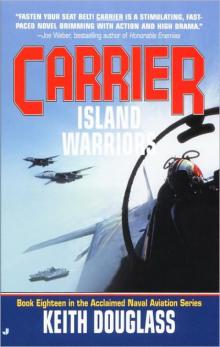 Island Warriors c-18
Island Warriors c-18 Afterburn c-7
Afterburn c-7 Terror At Dawn c-21
Terror At Dawn c-21 Specter sts-2
Specter sts-2 Joint Operations c-16
Joint Operations c-16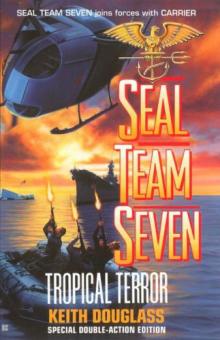 Tropical Terror sts-12
Tropical Terror sts-12 Seal Team Seven 7 - Deathrace
Seal Team Seven 7 - Deathrace Counterfire sts-16
Counterfire sts-16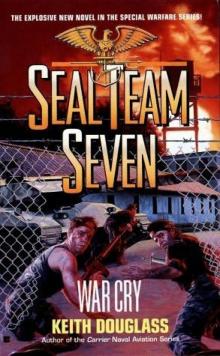 War Cry sts-9
War Cry sts-9 Chain of Command c-12
Chain of Command c-12 Brink of War c-13
Brink of War c-13 Armageddon Mode c-3
Armageddon Mode c-3 Arsenal c-10
Arsenal c-10 Nucflash sts-3
Nucflash sts-3 Arctic Fire c-9
Arctic Fire c-9 Firestorm sts-5
Firestorm sts-5 Typhoon Season c-14
Typhoon Season c-14 Alpha Strike c-8
Alpha Strike c-8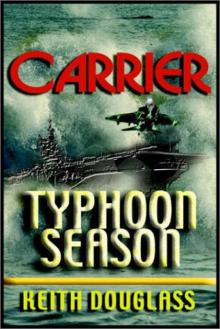 Carrier 14 - TYPHOON SEASON
Carrier 14 - TYPHOON SEASON Bloodstorm sts-13
Bloodstorm sts-13 Ambush sts-15
Ambush sts-15 First Strike c-19
First Strike c-19 Flame Out c-4
Flame Out c-4 Enemies c-15
Enemies c-15 Seal Team Seven 04 - Direct Action
Seal Team Seven 04 - Direct Action Seal Team Seven 01 - Seal Team Seven
Seal Team Seven 01 - Seal Team Seven Payback sts-17
Payback sts-17 Death Blow sts-14
Death Blow sts-14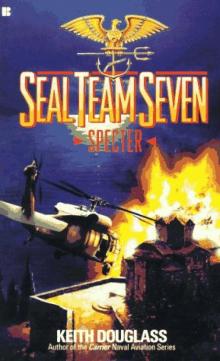 Seal Team Seven 02 - Spector
Seal Team Seven 02 - Spector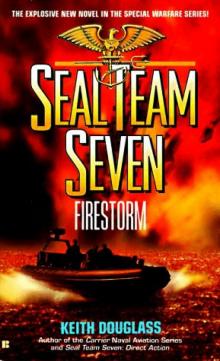 Seal Team Seven 5 - Firestorm
Seal Team Seven 5 - Firestorm The Art of War c-17
The Art of War c-17 Flashpoint sts-11
Flashpoint sts-11 Carrier - Joint Operation Book 16
Carrier - Joint Operation Book 16 Frontal Assault sts-10
Frontal Assault sts-10 Battleground sts-6
Battleground sts-6 Direct Action sts-4
Direct Action sts-4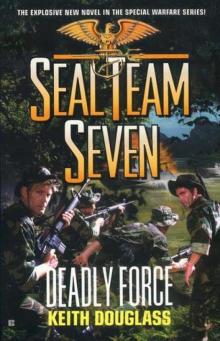 Deadly Force sts-18
Deadly Force sts-18 Carrier 13 - Brink of War
Carrier 13 - Brink of War Pacific Siege sts-8
Pacific Siege sts-8 Deathrace sts-7
Deathrace sts-7